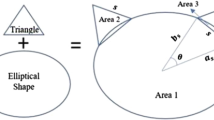Abstract
The effect of mobile phones on human health is becoming a serious concern in the last decade. This paper suggests a novel water-based cellular phone antenna for reducing the electromagnetic wave radiation toward human head. Two antennas are considered: a single band PIFA operating at 1.8 GHz, and a dual band PIFA operating at 900 MHz and 1.8 GHz. The specific absorption rate (SAR) is decreased up to 0.6 W/kg by limiting the propagation of near electromagnetic fields toward the human head and therefore reducing the current density distribution. The reduction of SAR is carried out by introducing an U-edge wall made of an absorbing water material at each corner of the ground plane.
























Similar content being viewed by others
References
Lavanya, A. B. (2014). Effects of electromagnetic radiation on biological systems: A short review of case studies. In 8th international conference on electromagnetic interference and compatibility (IEEE Cat. No. 03TH8706).
Sienkiewicz, Z. J. (1997). Biological effects of electromagnetic fields and radiation. In IEEE colloquium on electromagnetic hazards, safety and human interaction (Digest No. 1997/056).
Faruque, M. R. I., & Islam, M. T. (2013). Novel triangular metamaterial design for electromagnetic absorption reduction in human head. Progress in Electromagnetics Research, 141, 463–478.
Mary, T. A. J., & Ravichandran, C. S. (2012). SAR reduction in slotted PIFA for mobile handsets using RF shield. ARPN Journal of Engineering and Applied Sciences, 7(11), 1501–1505.
Sultan, K. S., Abdullah, H. H., Abdallah, E. A., & Hashish, E. A. (2013). Low SAR, compact and multiband antenna. In PIERS proceedings. Taipei.
Faruque, M. R. I., Islam, M. T., & Ali, M. A. M. (2013). A new design of metamaterials for SAR reduction. Measurement Science Review, 13(2), 70–74.
Kusuma, A. H., Sheta, A. F., Elshafiey, I., Alkanhal, M., Aldosari, S., Siddiqui, Z., & Alshebeili, S. A. (2010). A novel low SAR PIFA for mobile terminal. In 2010 IEEE 21st international symposium on personal indoor and mobile radio communications (pp. 1–5).
Xing, L., Huang, Y., Shen, Y., Alja’afreh, S., Xu, Q., & Alrawashdeh, R. (2015). Further investigation on water antennas. IET Microwaves, Antennas & Propagation, 9(8), 735–741.
Balanis, C. A. (2005). Antenna theory: Analysis and design (3rd ed.). New York: Wiley.
Hirasawa, K., & Haneishi, M. (1992). Analysis, design, and measurement of small and low-profile antennas. Boston: Artech House.
Raad, H. (2017). SAR reduction for PIFA antennas used in mobile phones. In Advances in antenna engineering and wireless systems research (pp. 57–77). CreateSpace Independent Publishing Platform.
Xing, L. (2015). Investigations of water-based liquid antennas for wireless communications. The University of Liverpool Repository: https://livrepository.liverpool.ac.uk/2037241/.
Chou, H.-H., Hsu, H.-T., Chou, H.-T., Liu, K.-H., & Kuo, F.-Y. (2009). Reduction of peak SAR in human head for handset applications with resistive sheets (R-CARDS). Progress in Electromagnetics Research, PIER, 94, 281–296.
Chen, H. F., Lin, M.-Y., & Lin, K.-H. (2008). A V-shape edge-groove design for a finite ground plane to reduce pattern ripples of a monopole. IEEE Antennas and Wireless Propagation Letters, 7, 561–564.
Faruque, M. R. I., Islam, M. T., & Misran, N. (2010). SAR analysis in human head tissues for different types of antennas. World Applied Sciences Journal, 11, 1089–1096.
Abdulrazzaq, S. A., & Aziz, J. S. (2013). SAR simulation in human head exposed to RF signals and safety precautions. International Journal of Science, Engineering and Computer Technology, 3(9), 334–340.
Author information
Authors and Affiliations
Corresponding author
Rights and permissions
About this article
Cite this article
Nasser, N., Serhal, D., Barake, R. et al. A novel low SAR water-based mobile handset antenna. Analog Integr Circ Sig Process 96, 353–361 (2018). https://doi.org/10.1007/s10470-018-1130-8
Received:
Revised:
Accepted:
Published:
Issue Date:
DOI: https://doi.org/10.1007/s10470-018-1130-8




